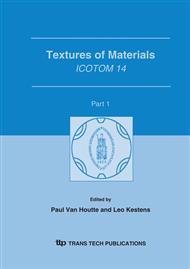p.971
p.977
p.983
p.989
p.995
p.1001
p.1007
p.1013
p.1019
Reaction Stress Model and Relaxation of Reaction Stress among the Grains during Tensile Deformation of fcc Metals
Abstract:
A reaction stress model is introduced in this paper and its applications for the crystallographic texture simulation are also discussed with the comparison to the classic Taylor type model and the self consistent model. This model took the external deformation stress tensor as an initial point, and the activation process of slip systems as well as the orientation evolutions was simulated step by step. Certain relaxation of reaction stress were introduced during tensile or drawing deformation, which predicts the tensile direction distribution along the orientation line between <111> and <100> in the inverse pole figure besides the <111> and <100> fiber texture. The simulation agrees with the common experimental observations. The model supplies a simple way to follow the deformation process in the main part of polycrystals, in which the effect of grain orientation and its interaction with the surrounding matrix are considered.
Info:
Periodical:
Pages:
995-1000
Citation:
Online since:
September 2005
Authors:
Keywords:
Price:
Сopyright:
© 2005 Trans Tech Publications Ltd. All Rights Reserved
Share:
Citation:


